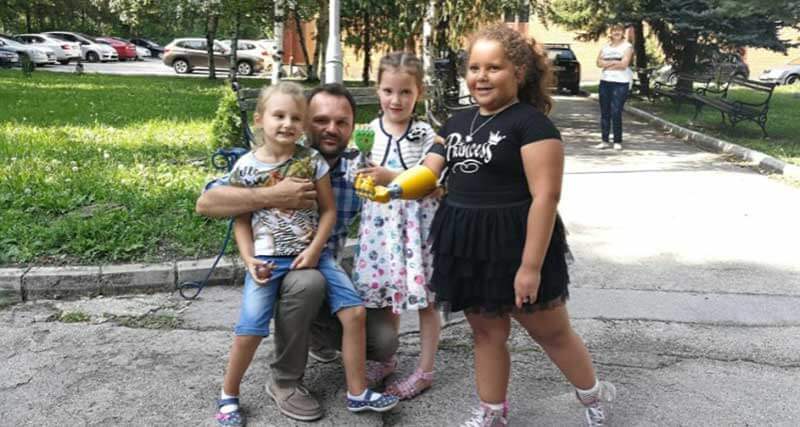- The e-NABLE project and the Good Samaritan from Zenica
- UK students develop a cheap robotic hand
- What does the future of 3D printing look like?
- Regaining independence and dignity shouldn’t be only for the privileged fe
Around 30 million people worldwide live with missing limbs. Many of them are unable to do things we take for granted, such as walking to a grocery store, driving a car, or even feeding themselves. Only 20 per cent are lucky enough to have access to prosthetics, whether because of their high costs, the distance to a hospital, or the simple unavailability of prostheses. However, new developments in 3D printing technology are set to make a significant difference in the lives of these people, even if the prosthetics aren’t as high-tech as some of the latest robotic versions we’ve written about before.
Advanced robotic prosthetics can cost up to £60,000, and for people without health insurance, this level of medical care is sadly out of reach. But thanks to new developments in 3D printing tech, a prosthetic limb doesn’t have to cost more than a few hundred dollars. Indeed, the potential applications for 3D printing in healthcare are exciting, and while experts around the world are working on next-gen, high-tech robotic prosthetics, many people – for instance, from the war-torn regions of Africa, the Middle East, and Bosnia – would be thrilled even with the most basic of prosthetics.
The e-NABLE project and the Good Samaritan from Zenica
“When his father saw him after the accident, he cried for two days,” says the mother of the 24-year old Ibrahim Lužić as she proudly looks at her son. But after doctors and engineers from Zenica, Bosnia, used a 3D-printed prosthetic implant for facial reconstruction, he’s now an ordinary-looking man, and only two years after a fall at a construction site, his life is back to normal. Grateful for his own results, Ibrahim asked the engineer Denis Spahić if he could also help his seven-year-old niece Adna Alićehajić, who was born without a forearm.
Spahić’s team, based at the University of Zenica’s iDEALab centre, wasted no time finding a solution. With the help of the global e-NABLE project, in which thousands of 3D printing experts share schematics of prosthetic limbs, Spahić managed to gather the initial data he needed. Then his team got to work to adjust the measurements, run tests, and solve technical problems. Once two prosthetic forearms were produced, one for Adna and one for another seven-year-old girl, Iris Badry, the team painted them to look like toys. And when the girls got their new presents, the smiles on their faces and the tears in their parents’ eyes assured Spahić’s team that they had succeeded once again.

This small team of students led by Spahić is pioneering medical 3D printing in Bosnia and Herzegovina. As he tells Richardvanhooijdonk.com, “The application of 3D printing in medicine is directly related to the type of 3D printer, software, and the employees’ expertise … these models can be used to plan surgeries, or to create implants.” And as this country, like many others, lacks experts in this field, he hopes the EU-financed iDEALab centre will motivate more young people to start studying 3D printing technology.
UK students develop a cheap robotic hand
Not only in Zenica, but all across the globe, inspired students are working on solutions to help underprivileged people. One of them is Alex Agboola-Dobson and his team of four at the University of Manchester. For their final-year project, these master’s students combined their knowledge of 3D printing, software, mechanics, and electrical engineering to create a 3D-printed robotic hand. Its mobile fingers can grab a cup of coffee, hold a phone, open a door, and even type on a keyboard. And while the prices of existing robotic hands are usually astonishingly high, the model built by these students costs only £307, proving that the only limit to the myriad of options for 3D printing tech in healthcare is the ingenuity of the researchers.

What does the future of 3D printing look like?
The range of existing 3D-printed medical devices is much more extensive than you might think. Surgical instruments, skull fragments, layers of skin, shells for hearing aids, hip joints, dental crowns, prosthetic limbs, and many other 3D-printed objects are already widely used. And fuelled by innovations, the global “3D printing healthcare market is expected to reach $2.3 billion by 2020”, an Allied Market Research report claims.
Spahić is optimistic about the possibilities of 3D printing and is convinced that mind-controlled prosthetics are the future. Although challenging, it’s certainly not impossible, and researchers led by Aldo Faisal at Imperial College London are already working in this direction. As Faisal explains, “We’re interested in understanding what algorithms the human brain uses to control movement, to make decisions. And of course, if we can reverse-engineer these algorithms, then the pathway to implementation is more straightforward.” Now they’re busy translating them for 3D bioprinters, with the hopes of one day using the technique in real-life surgical procedures. And with the Medical University of Vienna 3D printing a human placenta earlier this year, and the biotech company BIOLIFE4D aiming to print a human heart by 2019, even fully-functioning 3D-printed organs could be a reality sooner than we think.
Regaining independence and dignity shouldn’t be only for the privileged few
Despite the best efforts of scientists and doctors across the globe, more than 20 million people worldwide still don’t have access to prosthetic limbs. However, thanks to advances in 3D printing technology, the production of affordable prosthetic limbs is now becoming more feasible and the schematics for these devices can even be downloaded for free. As researchers in developed countries work on futuristic, high-tech 3D printing technologies, millions of disadvantaged people would be happy with even the most basic of options – a simple prosthetic limb to help them regain some independence and dignity. Thankfully, new developments in 3D printing tech are set to make a significant difference in the lives of these people, even if the prosthetics aren’t high-tech.
Share via:


